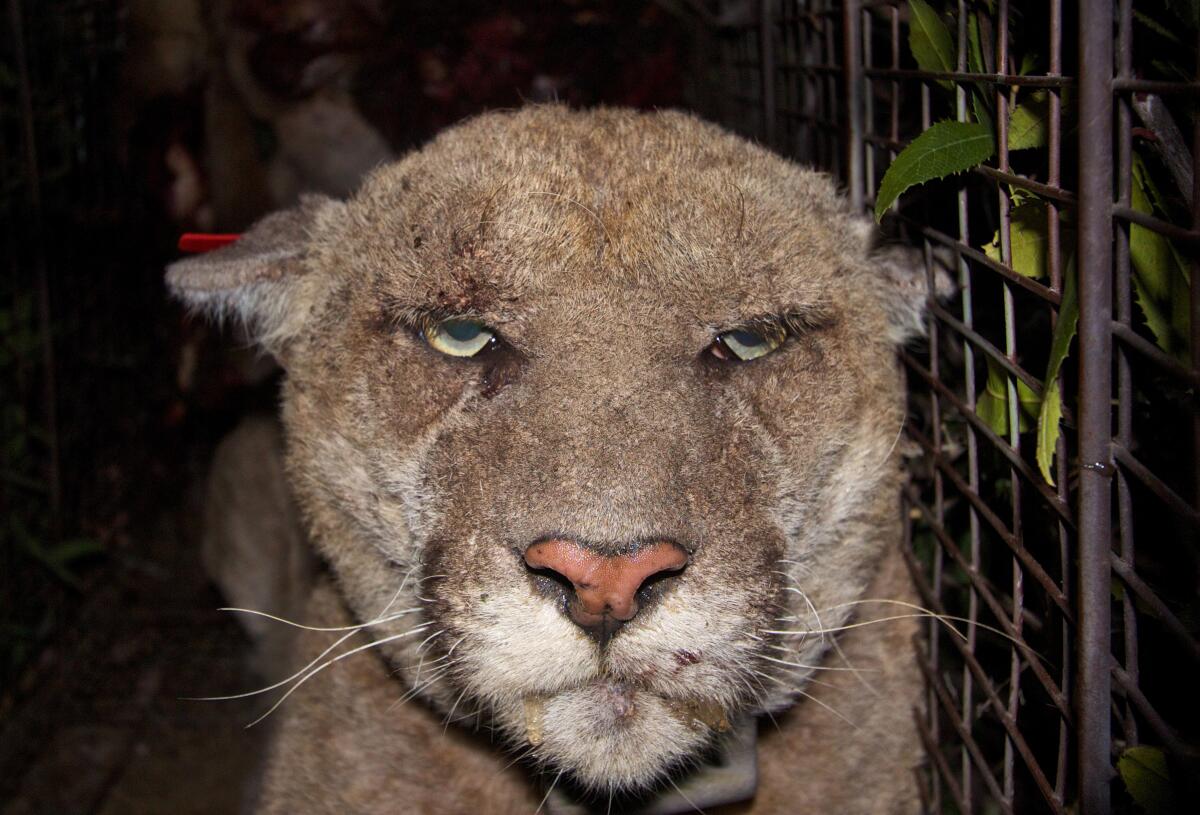Editorial: California’s rat poison bans aren’t working. Wild animals and pets are still dying

- Share via
For at least a decade, California has tried to restrict the use of rat poison so it stops killing all manner of creatures besides rats. So far, it hasn’t worked.
When a wild animal preys upon a rat that has ingested anticoagulant rodenticide, it can end up dead or sickened by the toxin as well. The poisoning continues up the food chain from predator to predator. Mountain lions, bobcats, foxes, coyotes, hawks as well as endangered species including the northern spotted owl and San Joaquin kit fox are among the wildlife that have been either killed by these rodenticides or made so ill that they can’t navigate their environment, hunt for food or dart across a road efficiently.
If mountain lions can’t cross a road to find mates and territory without risking their lives, that’s an eventual death sentence for the local population.
Anticoagulant rodenticides didn’t kill P-22, the beloved Griffith Park mountain lion, but they turned up in his system a couple of times — once causing a bout of mange for which he was lucky enough to receive treatment. Several different rat poisons were found in his system after he was euthanized in 2022, including diphacinone, a first-generation anticoagulant. Both of these rat poisons kill by causing internal bleeding. The older first-generation version is slower-acting, requiring the rat to feed on the poison several times before it is killed by it. The second-generation version kill rats more quickly.
Ten years ago the state prohibited the commercial sale of the more potent and fast-acting second-generation anticoagulant rodenticides, allowing them only to be used by professional exterminators. In 2020, the state Legislature decided to extend the ban to professional uses as well, except in some agricultural settings and in public health emergencies.
Bites are sending record numbers of Californians to the ER. Here’s how to prevent that from happening to you.
But the law still allowed consumers and professional exterminators to use first-generation rodenticides, which don’t act as quickly but still carry a powerful toxicity capable of sickening and sometimes killing the birds, mountain lions and other creatures that prey upon rats. A recent study of red-tailed hawks that ate prairie dogs poisoned with diphacinone showed signs of blood-clotting and trouble regulating their body temperatures.
Despite these efforts, non-target animals are still being poisoned by rodenticides, whether by accident or improper use. Necropsies of wild animals over the years have shown that wild animals and pets continue to end up as collateral damage of these toxins. Last year, state lawmakers adopted a moratorium on the use of diphacinone, the first-generation rodenticide most commonly found in the systems of poisoned wildlife, except in agricultural settings and public health emergencies. That ban took effect in January, so it has yet to have an impact, but there’s more that needs to be done to stop these terrible toxins.
Since the 1960s, a remnant population of sea otters has revived Monterey Bay. But they can’t migrate north throughout their historic range without human help.
Assembly Bill 2552,introduced this year by Laura Friedman (D-Glendale), could help curb the use of banned rodenticides by empowering all Californians to become enforcers. The bill, which is sponsored by wildlife advocacy groups, would allow members of the public to sue a person or company illegally using banned rodenticides. State and county agencies are tasked with enforcing the rodenticide laws but can’t begin to stop all the violations of the laws.
The bill also expands the ban to the remaining first-generation rodenticides, warfarin and chlorophacinone. And it forbids the use of all restricted rodenticides in parks and wildlife refuges, or within 5,000 feet of one.
This bill is crucial to ridding the environment of these toxins that kill wildlife and pets and have been known to poison people — usually children — as well.
And there’s no need for them. Covering trash receptacles, sealing up entry points to a house or building, and using nontoxic rodenticides and traps that don’t cause pain are all safer options to control rat populations. Fertility control products are also being used. One type is a plant-based liquid in bait stations that lowers fertility in rats (which breed prolifically). The liquid, which rats find delicious, has no hormones or chemicals to harm animals that prey upon rats. Various trials in city neighborhoods across the country have shown results as dramatic as a 90% reduction in rats after several months.
The text of the bill makes a point of stating that animals are capable of experiencing pain, stress and fear, and that they have “a right to a life free of poison.”
That language doesn’t imbue animals with rights that override human rights. If that were the case these rodenticides would be banned with no exceptions. But it does underscore something important — that humans should strive to minimize animals’ suffering especially when it is unnecessary. That is the case here.
More to Read
A cure for the common opinion
Get thought-provoking perspectives with our weekly newsletter.
You may occasionally receive promotional content from the Los Angeles Times.













